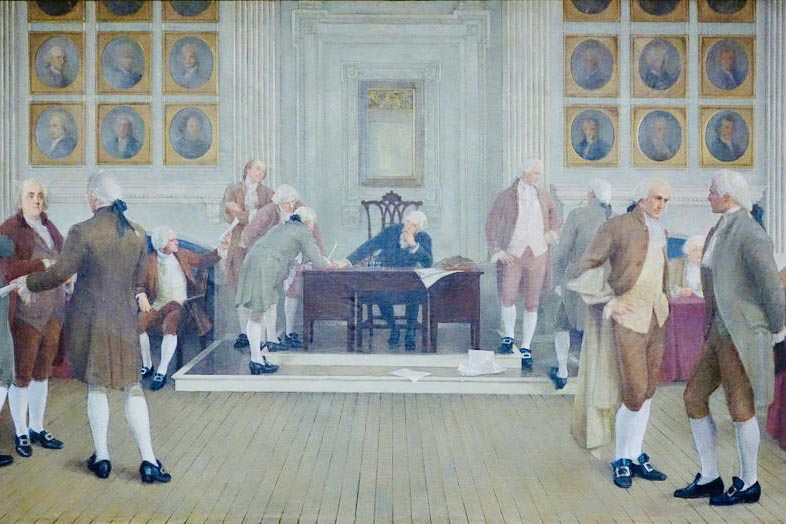1) Virginia was the first state to select delegates to the Grand Convention and took the lead in encouraging other states to do the same. The Virginia Legislature selected 7 delegates: Washington, Blair, Madison, Mason, McClurg, Randolph, and Wythe. They arrived in Philadelphia on time, but had to wait a couple of weeks until a quorum of seven states was achieved. The delegates were also united in their approach and this consensus was displayed right away with the presentation of the Virginia Plan.
2) Mr. Wythe left in early June, but there were no cracks then in the Virginia delegation. With the passage of the Connecticut Compromise on July 16, and the creation of the Committee of Detail at the end of July, Dr. McClurg returned to his medical practice in Virginia. All seemed to be pretty smooth sailing. But there were strains. Virginia voted no on the Connecticut Compromise that was adopted by the Convention. The alliance of Madison, Blair, and McClurg carried the no vote. Mason voted yes; he was part of the Compromise Committee, and certainly by the next day, Randolph came to agree with Mason that it was best to forge ahead.
3) The Connecticut Compromise has three parts a) equal representation for people in the House, b) equal representation for the states in the Senate and c) money bills can only be introduced in the House and can’t be amended by the Senate. This third component was critical in persuading Mason and Randolph to deviate from the Virginia Plan.
4) But things started to unravel in August. The once united and leading state was now divided and McClurg had returned to Virginia. And they divide on August 8 and 9 when Madison attempted to remove the third feature of the Compromise. Mason said that to “strike out this section was to unhinge the compromise of which it made a part.” Randolph said that the removal would lead to “endangering the success of the plan.” The delegations voted 7 yes, 4, no to strike out the third feature. Virginia voted to strike, so the internal Virginia vote must have been 3-2 and that could only have happened if Washington sided with Madison and Blair over against Mason and Randolph.
5) Randolph refused to accept defeat. On August 11, he persuaded the Convention to reconsider the August 8 vote to strike and the issue was debated thoroughly on August 13. Mason and Randolph saw principle to be at sake, Madison said nothing of principle was at stake in the Connecticut Compromise, and Dickinson observed that “experience must be our only guide. Reason may mislead us.” A vote was taken as to the “exclusive originating of money bills in the H. of Reps.”
6) Madison gives details of the August 13 vote that reinstated exclusive origination accompanied by a footnote explanation:
N. H. ay. Mas. ay. Ct. no. N. J. no. P. no. Md. No. Virga. ay. Mr Blair & Mr M. no” Mr. R. Col. Mason and General Washington* ay. N. C. ay. S. C. no. Geo. No [Ayes”4; noes”7.]
*He disapproved & till now voted agst., the exclusive privilege (see 4 above), he gave up his judgment he said, because it was not of very material weight with him & was made an essential point with others, who if disappointed, might be less cordial in other points of real weight.
Now I interpret this vote switch by Washington to be the action of a prudent leader, not only of a national convention, but of a Virginia delegation that was in serious disagreement. He realized that it was important to keep Randolph and Mason on board if possible so long as no fundamental principle had been violated. But Randolph and Mason held out for more.
7) On August 31, September 5, 8, and 10, the delegates, especially the Virginia delegates, divided over ratification procedures. Should ratification be by state legislatures or state conventions, and if by conventions, how many should say “yes” for ratification? What is the role of these conventions? Can they propose amendments? What about the role of the existing Congress? Can they make alterations? Should there be a Second Grand Convention where all these things are pulled together?
8) Randolph and Mason wanted maximum flexibility otherwise they would refuse to sign. On September 10, Randolph gave 12 reasons why he couldn’t sign”including the “smallness of the number of the Representative branch””that could only be overcome by following a long ratification route through the Congress, the states, and back to a SECOND CONVENTION. Mason urged the delegates to see what they could do to accommodate Randolph, but on September 12 he issued 16 reasons why he too couldn’t sign the Constitution.
9) Mason and Randolph repeated their objections on September 15. Randolph, seconded by Mason, moved that if the delegates agreed “with the expedient of another Convention as proposed, he could sign.” Madison reports: “On the question on the proposition of Mr. Randolph. All the States answered-no.” Virginia could only have voted no if Washington sided with Madison and Blair over against Mason and Randolph.
10) The last three lines of Madison’s Notes on the 15th are worth citation: “on the question to agree to the Constitution as amended. All the States ay. The Constitution was then ordered to be engrossed. And the House adjourned.”
If Washington had not acted, Virginia would have been divided between the two camps and could not have voted “ay.” Even on the last day, September 17, Washington reached out to Randolph and spoke for the first time urging the delegates to increase the size of the representative branch. The delegates agreed, but it was not enough to get Randolph and Mason to sign.
